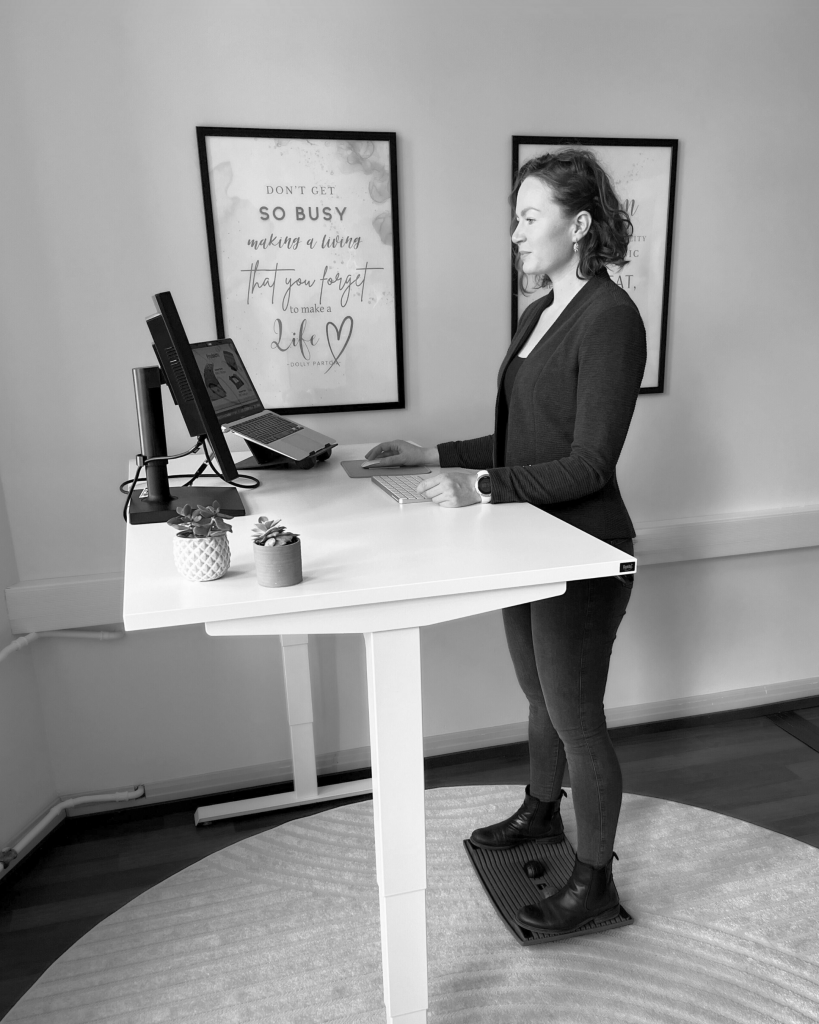The best standing desk solutions for people with chronic lower back pain combine proper height adjustability, stability, and ergonomic accessories. Look for desks with smooth electric height adjustment, memory settings, and adequate workspace. When paired with anti-fatigue mats or other proper ergonomic setup, a good standing desk can significantly reduce lower back strain by promoting position changes throughout the day. The ideal solution encourages natural movement while maintaining proper posture in both sitting and standing positions.
Understanding standing desks and lower back pain
Chronic lower back pain and sedentary work habits often go hand in hand. Sitting for extended periods places significant pressure on your spine, particularly in the lumbar region, leading to muscle tension, reduced circulation, and potential disc compression. Standing desks address this issue by allowing you to alternate between positions throughout your workday.
When you switch between sitting and standing, you engage different muscle groups, improve blood flow, and reduce the static load on your spine. This movement variation is particularly beneficial for those with chronic lower back pain, as it prevents any single position from causing prolonged strain.
The key benefit isn’t necessarily standing instead of sitting, but rather the ability to change positions regularly. Your body is designed for movement, and even small position adjustments throughout the day can help alleviate pain and improve overall back health. A properly configured standing desk setup creates an environment where these movements happen naturally and comfortably.
What features should you look for in a standing desk for chronic back pain?
When shopping for a standing desk to help manage lower back pain, prioritise smooth, quiet electric height adjustment that allows you to change positions without straining. Look for desks with memory settings to save your ideal sitting and standing heights, making transitions effortless and consistent.
Stability is non-negotiable, especially at maximum height. A wobbling desk can cause you to compensate with poor posture, potentially worsening back pain. Test the desk’s stability at various heights before purchasing, or check reviews specifically mentioning stability.
Consider the desk’s height range to ensure it accommodates your specific body measurements. The optimal standing desk should adjust low enough for proper sitting ergonomics and high enough that your forearms rest at a 90-degree angle when standing. Some models also offer depth adjustability for monitor positioning, which helps maintain proper neck alignment.
The desktop size and shape matter too. Ensure you have adequate space for all your work essentials without overreaching, which can strain your back. Some desks feature contoured edges that allow you to rest your arms comfortably, reducing shoulder tension that can contribute to back issues.
How do you properly set up a standing desk to minimize back pain?
Setting up your standing desk correctly is crucial for back pain relief. Start by positioning your monitor at eye level, with the top of the screen slightly below or at eye height. This prevents you from looking down, which strains your neck and upper back. The monitor should be approximately an arm’s length away.
Place your keyboard and mouse at a height where your elbows can bend at 90 degrees with your wrists straight, not bent up or down. Your forearms should be parallel to the floor whether sitting or standing. Consider using a keyboard tray if needed to achieve this positioning.
When standing, distribute your weight evenly on both feet and stand with a slight bend in your knees—never lock them. Keep your feet hip-width apart and consider placing one foot slightly forward, alternating throughout the day. This stance helps maintain the natural curve in your lower back.
Use an anti-fatigue mat directly under your standing position to provide cushioning and encourage subtle movements. Place any frequently used items within easy reach to avoid twisting or stretching that might trigger back pain.
Remember to check your posture regularly: shoulders relaxed, head balanced above shoulders, and lower back maintaining its natural curve—neither too arched nor too flat.
How long should you stand at a standing desk with back pain?
When using a standing desk with chronic back pain, follow the 30-30 rule: aim to alternate between 30 minutes of sitting and 30 minutes of standing throughout your day. However, listen to your body—this ratio should be personalised based on your comfort level and condition severity.
Begin gradually if you’re new to standing desks. Start with just 15-20 minutes of standing per hour and increase incrementally over several weeks. Your body needs time to build endurance for standing, particularly if you’ve been primarily sedentary.
Pay attention to warning signs that indicate you should change positions: increased pain, fatigue, shifting weight frequently from one leg to another, or leaning on your desk for support. These signals suggest your muscles are fatigued and it’s time to sit.
Incorporate micro-movements while standing—small weight shifts, gentle stretches, or subtle rocking motions—to keep blood flowing and muscles engaged. These subtle movements are often more beneficial than strictly standing still.
Remember that the goal isn’t to stand all day, which can create its own problems. The benefit comes from the regular position changes and movement variety, not from avoiding sitting altogether.
What complementary products work best with standing desks for back pain relief?
An anti-fatigue mat is a helpful companion to your standing desk in managing back pain. These mats provide cushioning that reduces pressure on your spine and encourages subtle foot and leg movements. Look for one with varied terrain features that promote different standing positions.
For sitting intervals, invest in an ergonomic chair with proper lumbar support that maintains your spine’s natural curve. Adjustable armrests and seat depth allow for personalised comfort that complements your standing periods.
Balance boards or active boards offer an active standing option that strengthens core muscles while improving posture. These boards create controlled instability that engages stabilising muscles around your spine, potentially providing relief through improved muscular support.
A monitor arm allows precise positioning of your screen regardless of desk height, ensuring proper neck alignment in both sitting and standing positions. This flexibility is particularly important when managing back pain that might be aggravated by poor neck posture.
Consider a keyboard tray that adjusts independently from your desk height, allowing for optimal wrist positioning that prevents compensation patterns that might stress your back. Similarly, an ergonomic mouse can reduce upper body tension that often contributes to back issues.
Key takeaways for choosing the right standing desk solution
The ideal standing desk solution for chronic lower back pain is one that promotes movement variety throughout your workday. Focus on smooth transitions between positions rather than seeking to eliminate sitting entirely. Your body thrives on movement, not static postures of any kind.
Personalisation is essential—what works for someone else might not work for you. Consider your specific pain patterns, work requirements, and body mechanics when selecting and setting up your desk system.
Remember that a standing desk is a tool, not a complete solution. Combine it with regular stretching, proper ergonomics, and movement breaks for maximum benefit. Even the best desk cannot overcome poor usage habits.
Gradual adaptation is crucial for success. Your body needs time to adjust to new working positions, especially if you’ve been predominantly sedentary. Patience with this transition process prevents additional strain.
At Gymba, we understand the importance of natural movement for back health. Our ergonomic solutions complement standing desks by encouraging subtle, beneficial movements throughout the day. Products like our Activation Board provide a way to incorporate active standing that improves circulation and engages core muscles while you work—helping you stay comfortable and pain-free.

